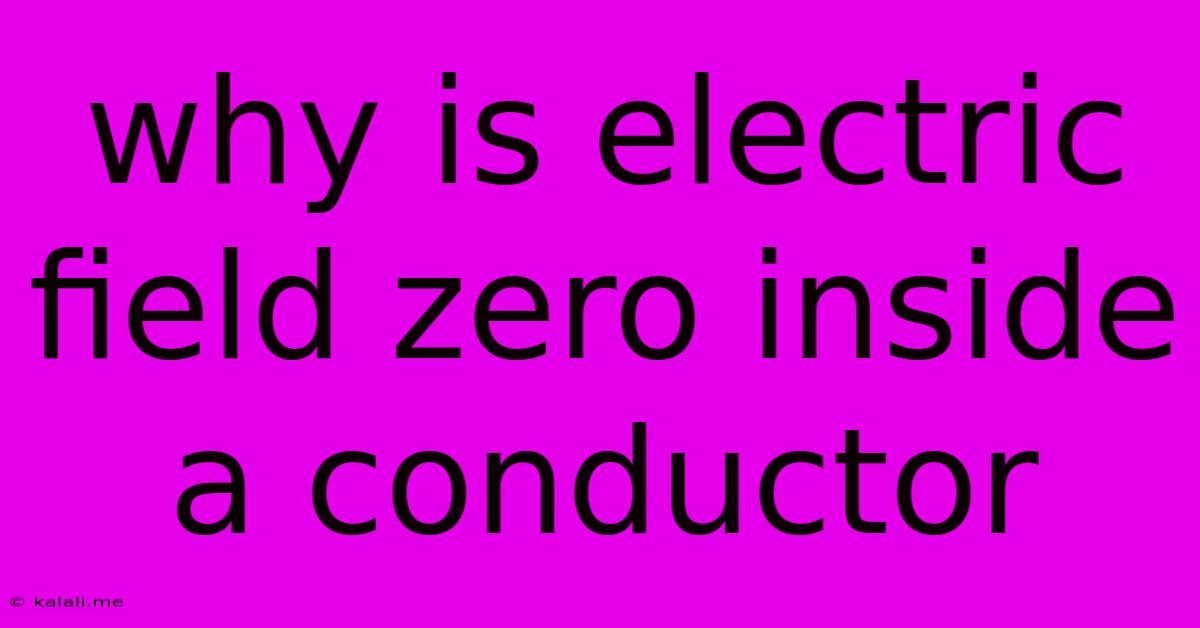Why Is Electric Field Zero Inside A Conductor
Kalali
May 27, 2025 · 3 min read

Table of Contents
Why is the Electric Field Zero Inside a Conductor?
Meta Description: Discover the fundamental principle behind why the electric field inside a conductor is always zero, exploring the behavior of free charges and the concept of electrostatic equilibrium. Learn about the implications of this principle in various electrical phenomena.
Understanding why the electric field inside a conductor is zero is crucial for grasping many fundamental concepts in electromagnetism. This isn't just a theoretical curiosity; it's a cornerstone principle that underpins the workings of numerous electrical devices and phenomena. Let's delve into the reasons behind this important fact.
The Role of Free Charges
Conductors, by definition, contain a large number of free charges – typically electrons – that are not bound to specific atoms and are free to move throughout the material. This mobility is the key to understanding why the electric field inside a conductor is zero under electrostatic conditions (i.e., when there's no current flow).
Imagine an external electric field applied to a conductor. This field will exert a force on the free charges within the conductor. Because these charges are free to move, they'll respond to this force. Positive charges will move in the direction of the field, and negative charges (electrons) will move against the field. This movement of charges constitutes a current.
Achieving Electrostatic Equilibrium
This current continues until a crucial point is reached: electrostatic equilibrium. At this point, the charge distribution within the conductor has rearranged itself in such a way that it completely cancels out the external electric field inside the conductor. This cancellation is not a coincidence; it's a direct consequence of the free charges' response to the external field.
The charges redistribute themselves on the surface of the conductor. This surface charge density creates an internal electric field that is exactly equal and opposite to the external field. The net effect? A zero electric field within the conductor.
Implications of Zero Electric Field
This principle has several significant implications:
-
Shielding: A conductor acts as an electrostatic shield. If you place a conductor around a charged object, the electric field inside the conductor will be zero, regardless of the charge distribution outside. This shielding effect is vital in protecting sensitive electronic components from external electromagnetic interference (EMI).
-
Capacitance: The ability of a conductor to store charge is directly related to its geometry and the presence of other conductors nearby. The zero electric field inside a conductor is a critical factor in calculating capacitance.
-
Lightning Rods: The principle of electrostatic equilibrium and the resulting zero electric field inside a conductor explains why lightning rods are effective in protecting buildings from lightning strikes. The lightning rod provides a path for the charge to flow to the ground, preventing the buildup of charge and minimizing the risk of a strike.
Exceptions and Considerations
It's important to note that this principle holds true only under static conditions. If the external electric field changes rapidly (e.g., due to a time-varying electromagnetic field), the charges inside the conductor will not have enough time to redistribute themselves completely, and a small electric field may exist within the conductor momentarily. This is the basis of electromagnetic induction and the operation of devices like transformers.
In summary, the zero electric field inside a conductor under electrostatic conditions is a direct result of the mobility of free charges within the conductor and their ability to redistribute themselves until an equilibrium state is reached where the internal and external electric fields cancel each other out. This fundamental principle has wide-ranging applications and implications across various areas of electrical engineering and physics.
Latest Posts
Latest Posts
-
Scp Copy From Local To Remote
May 28, 2025
-
Ha Ha Ha Jokes On You Batman
May 28, 2025
-
Replaced Batteries In Thermostat Wont Turn On
May 28, 2025
-
Fire In Oven While Self Cleaning
May 28, 2025
-
How To Fix A Loose Doorknob With No Visible Screws
May 28, 2025
Related Post
Thank you for visiting our website which covers about Why Is Electric Field Zero Inside A Conductor . We hope the information provided has been useful to you. Feel free to contact us if you have any questions or need further assistance. See you next time and don't miss to bookmark.